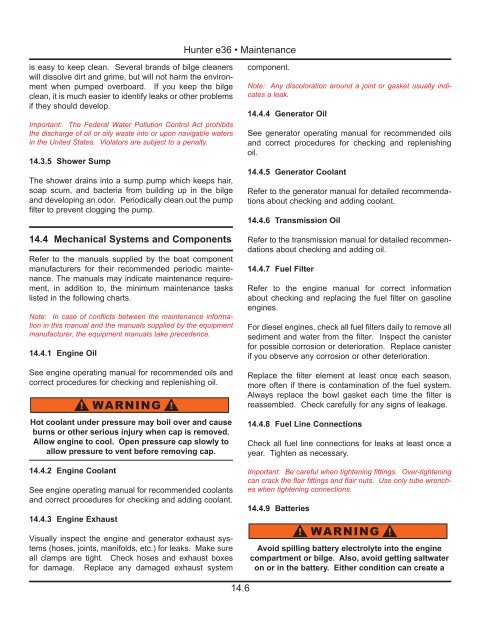36e Operator's Manual 2013.pdf - Marlow-Hunter, LLC
36e Operator's Manual 2013.pdf - Marlow-Hunter, LLC
36e Operator's Manual 2013.pdf - Marlow-Hunter, LLC
- No tags were found...
You also want an ePaper? Increase the reach of your titles
YUMPU automatically turns print PDFs into web optimized ePapers that Google loves.
<strong>Hunter</strong> e36 • Maintenanceis easy to keep clean. Several brands of bilge cleanerswill dissolve dirt and grime, but will not harm the environmentwhen pumped overboard. If you keep the bilgeclean, it is much easier to identify leaks or other problemsif they should develop.Important: The Federal Water Pollution Control Act prohibitsthe discharge of oil or oily waste into or upon navigable watersin the United States. Violators are subject to a penalty.14.3.5 Shower SumpThe shower drains into a sump pump which keeps hair,soap scum, and bacteria from building up in the bilgeand developing an odor. Periodically clean out the pumpfilter to prevent clogging the pump.14.4 Mechanical Systems and ComponentsRefer to the manuals supplied by the boat componentmanufacturers for their recommended periodic maintenance.The manuals may indicate maintenance requirement,in addition to, the minimum maintenance taskslisted in the following charts.Note: In case of conflicts between the maintenance informationin this manual and the manuals supplied by the equipmentmanufacturer, the equipment manuals take precedence.14.4.1 Engine OilSee engine operating manual for recommended oils andcorrect procedures for checking and replenishing oil.! WARNING !Hot coolant under pressure may boil over and causeburns or other serious injury when cap is removed.Allow engine to cool. Open pressure cap slowly toallow pressure to vent before removing cap.14.4.2 Engine CoolantSee engine operating manual for recommended coolantsand correct procedures for checking and adding coolant.14.4.3 Engine ExhaustVisually inspect the engine and generator exhaust systems(hoses, joints, manifolds, etc.) for leaks. Make sureall clamps are tight. Check hoses and exhaust boxesfor damage. Replace any damaged exhaust systemcomponent.Note: Any discoloration around a joint or gasket usually indicatesa leak.14.4.4 Generator OilSee generator operating manual for recommended oilsand correct procedures for checking and replenishingoil.14.4.5 Generator CoolantRefer to the generator manual for detailed recommendationsabout checking and adding coolant.14.4.6 Transmission OilRefer to the transmission manual for detailed recommendationsabout checking and adding oil.14.4.7 Fuel FilterRefer to the engine manual for correct informationabout checking and replacing the fuel filter on gasolineengines.For diesel engines, check all fuel filters daily to remove allsediment and water from the filter. Inspect the canisterfor possible corrosion or deterioration. Replace canisterif you observe any corrosion or other deterioration.Replace the filter element at least once each season,more often if there is contamination of the fuel system.Always replace the bowl gasket each time the filter isreassembled. Check carefully for any signs of leakage.14.4.8 Fuel Line ConnectionsCheck all fuel line connections for leaks at least once ayear. Tighten as necessary.Important: Be careful when tightening fittings. Over-tighteningcan crack the flair fittings and flair nuts. Use only tube wrencheswhen tightening connections.14.4.9 Batteries! WARNING !Avoid spilling battery electrolyte into the enginecompartment or bilge. Also, avoid getting saltwateron or in the battery. Either condition can create a14.6

















